Tour de France 2024 stage-by-stage guide: Route maps and profiles for all 21 days
The 2024 Tour de France is a truly unique race beginning in Florence and ending – for the first time in its 121-year history – outside Paris.
This year’s Tour will wrap up without the usual procession to the Champs-Elysees, where security resources will be focused on the Paris Olympics starting five days later. Instead, organisers have opted to end the race with an individual time-trial in Nice, adding the possibility of the yellow jersey changing hands on a dramatic final day.

Before that, riders face a typically gruelling challenge, with a hilly start in Italy before crossing to France where a perilous gravel stage awaits in Troyes. Week two leads the peloton south to the Pryenees and the monstrous Col du Tourmalet, before a series of days in the Alps including a particularly brutal stage 19 with a summit finish in Isola.
It all concludes in Nice on Sunday 21 July, where the race winner will be crowned.
Stage 1: Florence to Rimini (hilly, 206km) | Saturday 29 June

The opening stage of the 2024 Tour de France will be a beautiful ride, starting with the Grand Depart on the banks of the Arno river in the centre of Florence before heading through Tuscany to the finish line on Italy’s east coast, on the beachfront of Rimini. The route also takes in San Marino, the Tour’s 13th country. But it will be tough on what is the most hilly first stage in the race’s history with 3,600m of climbing to conquer. It could be a day for Tadej Pogacar to immediately make his mark, or for an outstanding classics rider like Mathieu van der Poel to target, while young puncheurs like Ireland’s Ben Healy and Belgium’s Maxim Van Gils could be outside bets.

Stage 2: Cesenatico to Bologna, (hilly, 199km) | Sunday 30 June
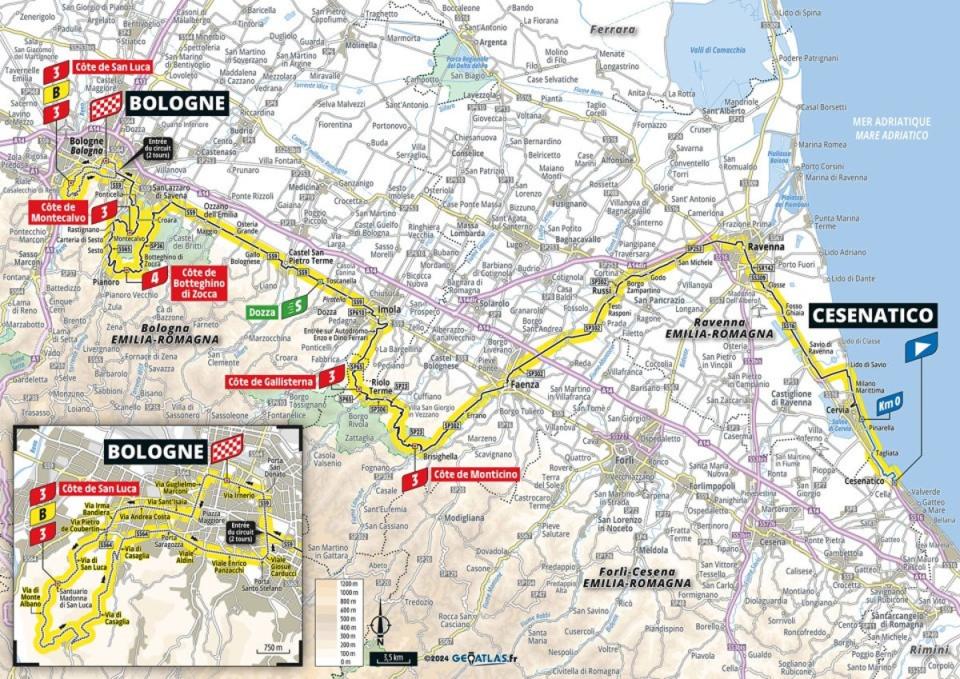
The second day throws up a more gentle ride, though it still contains six categorised climbs to test the legs. The purest sprinters will get left behind but the small ascents are unlikely to put off the more hardy fast men, like Wout van Aert, who will like the look of the fast finish in Bologna.

Stage 3: Plaisance to Turin (flat, 231km) | Monday 1 July

The long third stage will be the first opportunity for a bunch sprint to the finish line. Expect Alpecin-Deceuninck to try and control the final kilometres in an effort to position Jasper Philipsen for the win, but there is a stacked list of sprinters ready to challenge him including Arnaud de Lie, Dylan Groenewegen, Sam Bennett, Wout van Aert and Mark Cavendish, chasing a record 35th stage win to finally eclipse the great Eddy Merckx.

Stage 4: Pinerolo to Valloire (mountainous, 140km) | Tuesday 2 July

A tough fourth stage takes the riders into France via a couple of testing category-two climbs and to the foot of the Col du Galibier – the first hors categorie ascent of the race. The gradient averages only 5.3% but at 23km long, it is a draining slog of a climb to the top and the strongest climbers will come to the fore. Expect some attacks among the big hitters like Tadej Pogacar and Jonas Vingegaard as we get our first real sense of the battle for overall victory.

Stage 5: Saint-Jean-de-Maurienne to Saint-Vulbas (flat, 177km) | Wednesday 3 July
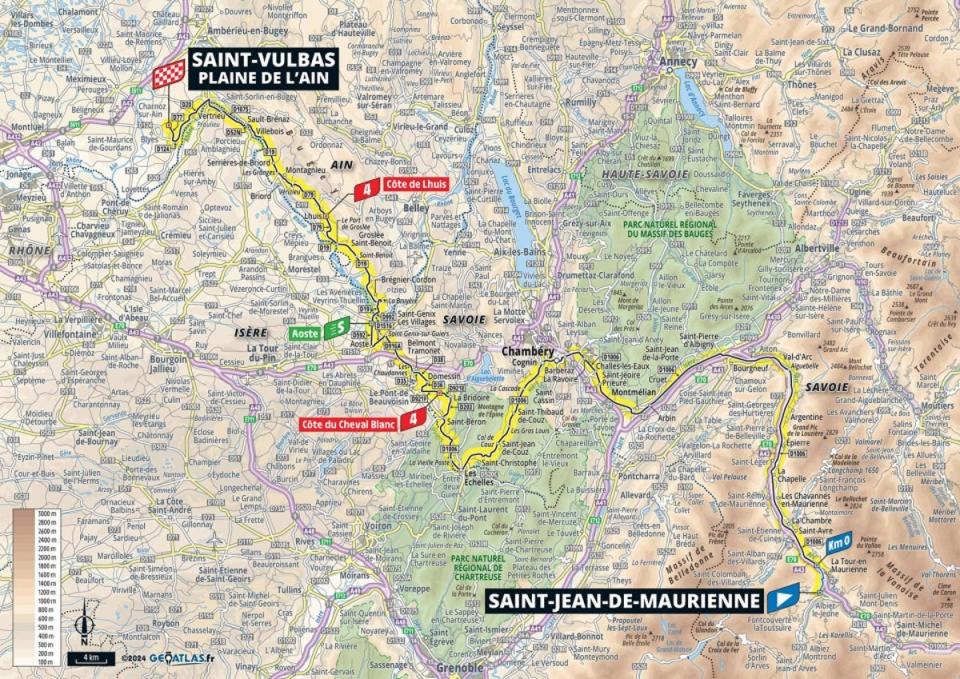
The second sprint finish of this year’s Tour contains some small hills but nothing that should disrupt the power riders from reaching the finish near the front, where they will expect to battle for victory.

Stage 6: Macon to Dijon (flat, 163km) | Thursday 4 July
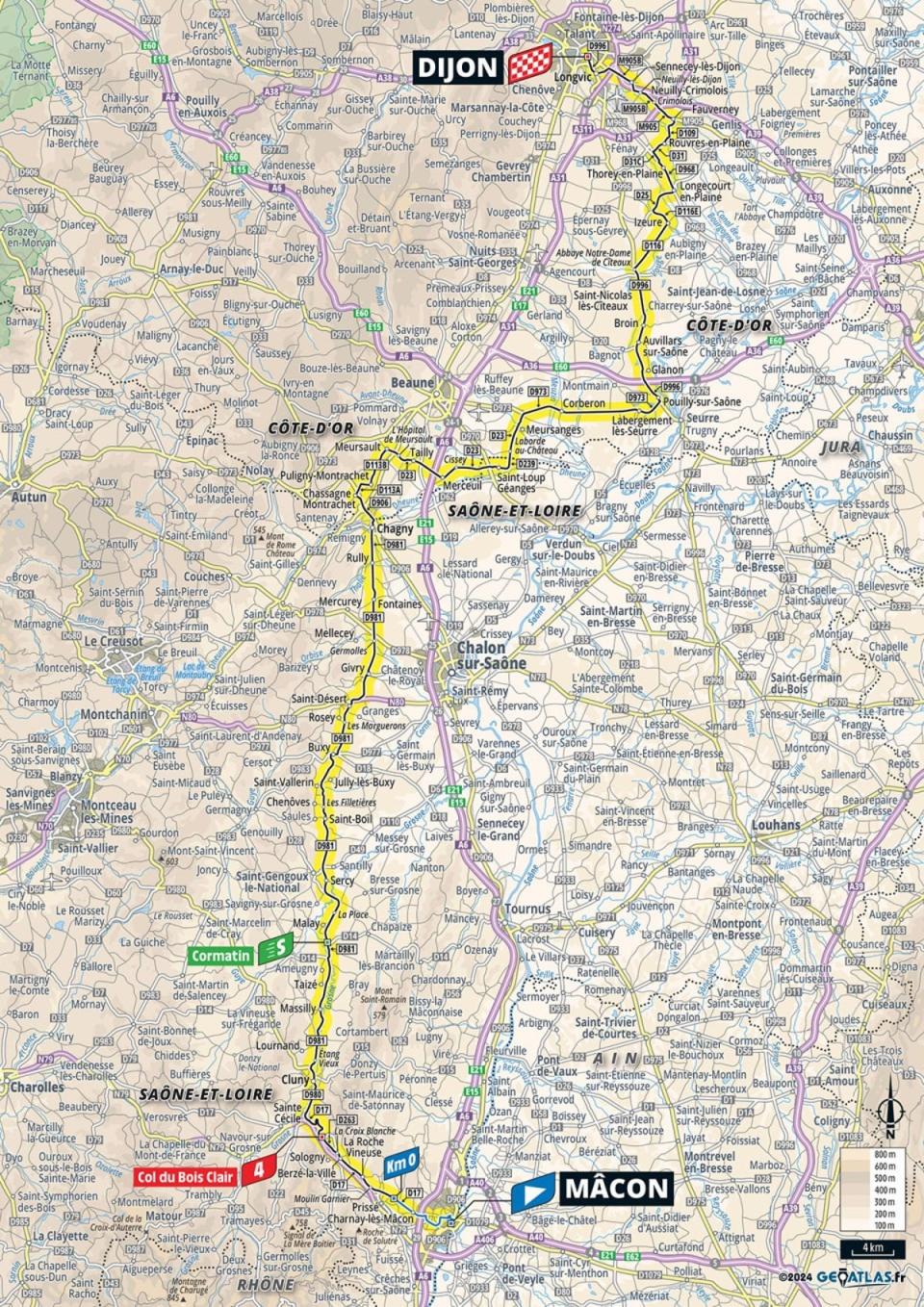
An even flatter day looks ripe for a bunch sprint on the streets of Dijon. One small categorised climb early in the stage precedes an intermediate sprint which might be targeted by those hunting the green jersey, and a breakaway will almost certainly then take to the front of the race. But it is likely to be caught by the sprinters’ teams before the finish as the peloton’s power riders fight for the stage win.
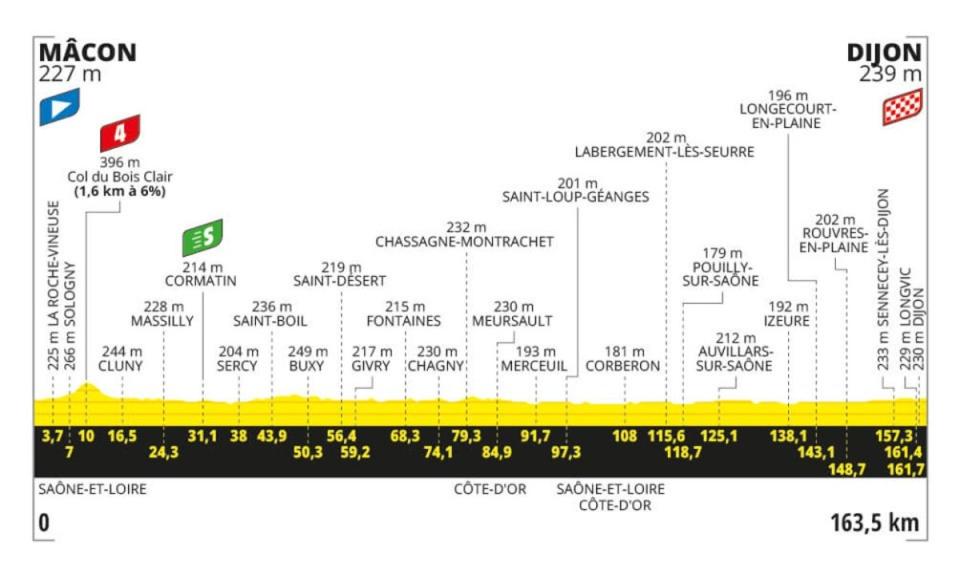
Stage 7: Nuits-Saint-Georges to Gevrey-Chambertin, (ITT, 25km) | Friday 5 July

The first individual time-trial of this year’s Tour de France sweeps through thick forest before opening out into the picturesque vineyards of Burgundy. The only climb is the short Cote de Curtil-Vergy (1.6km at 6.1%), followed by a descent into Gevrey-Chambertin, and here Remco Evenepoel – the reigning time-trial world champion – will plan to take some time from his general classification rivals who are less adept against the clock.

Stage 8: Semur-en-Auxois to Colombey-les-Deux-Eglises (flat, 176km) | Saturday 6 July

It may be officially listed as a flat day, but stage eight contains five categorised climbs and plenty more undulation, along with an uphill drag to the finish which should be enough to shake out some of the pure sprinters from contention. This could be a bunch sprint, a day for the breakaway or even a bold solo attack if the situation presents itself for an opportunist near the front of the race.

Stage 9: Troyes to Troyes (hilly, 199km) | Sunday 7 July

The Tour de France takes on the gravel roads of the Champagne region to see out the first week, and the white dusty terrain could take down a few unfortunate victims. The 14 sections of gravel span 32km in all, and they are similar to the roads of the iconic Italian race, Strade-Bianche. The past winners of Strade-Bianche – Tom Pidcock, Mathieu van der Poel, Wout van Aert and Tadej Pogacar – will fancy their chances here.

Rest day: Orleans | Monday 8 July
Stage 10: Orleans to Saint-Amand-Montrond (flat, 187km) | Tuesday 9 July

The Tour heads down to the centre of France, where on paper it is a nice-looking day for the sprinters, but they will need to stay alert to winds which could split the pack along this twisting route south to Saint-Amand-Montrond in the Loire Valley. A short, sharp climb 8km from the finish could be the launchpad for a brave attack, though the muscle men of the peloton will hope to fight it out against each other at the finish in Saint-Amand-Montrond.

Stage 11: Evaux-les-Bains to Le Lioran, (mountainous, 211km) | Wednesday 10 July
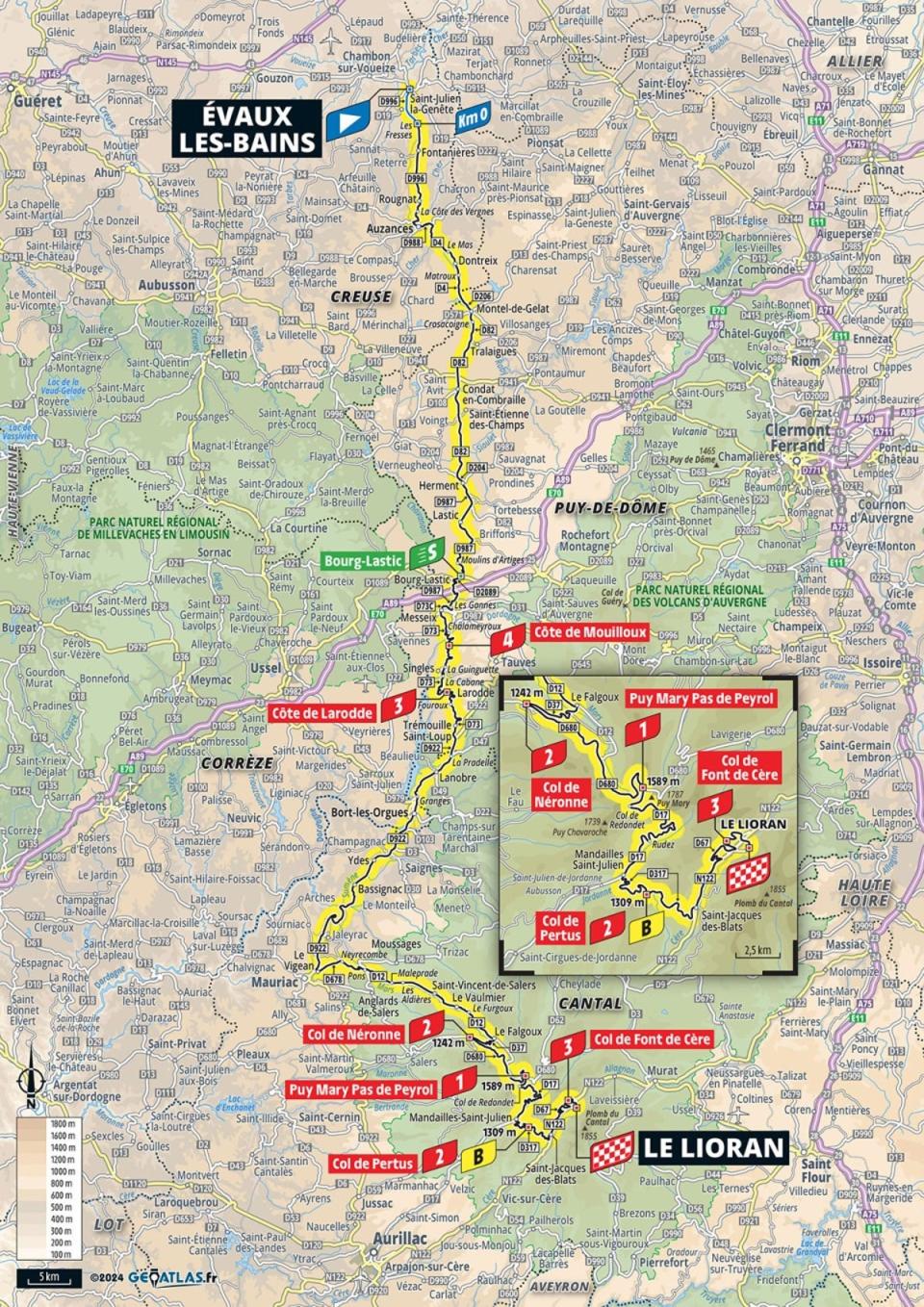
Six categorised climbs pepper a hard up-and-down day through the Massif Central. The third-from-last ascent is the toughest, the Puy Mary Pas de Peyrol (5.4km at 8.1%), with a painfully steep final 2km to conquer, and strong climbing legs will be needed to win the stage. A good day for a breakaway to escape and potentially stay away to the end.

Stage 12: Aurillac to Villeneuve-sur-Lot, (flat, 204km) | Thursday 11 July

The ‘flat’ categorisation disguises the numerous small hills dotted through this picturesque route to Villeneuve which will drain legs if the pace is high. Expect a determined breakaway to make it difficult for those teams hoping to set up a bunch sprint at the finish – twice before, the day has been won by a rider in the breakaway here.
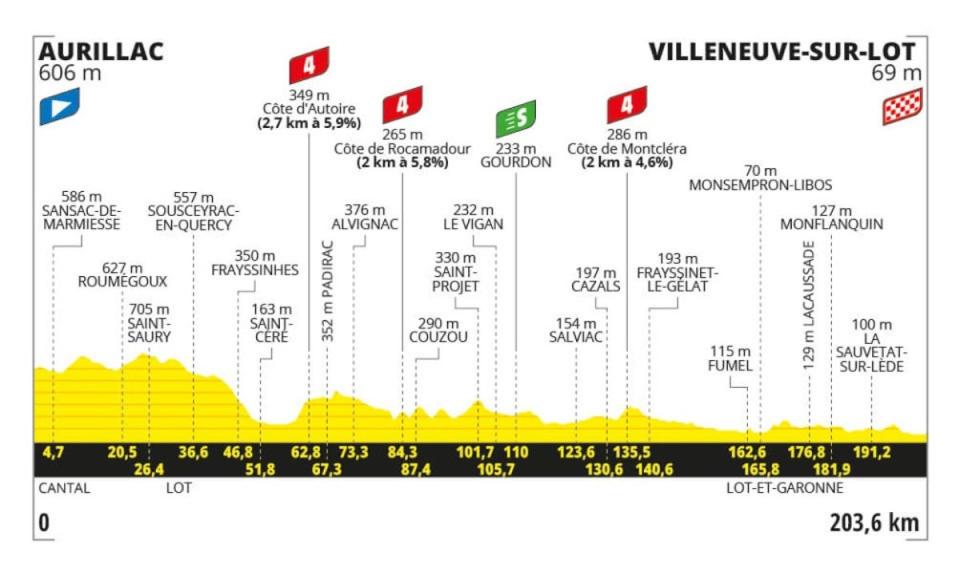
Stage 13: Agen to Pau, (flat, 165km) | Friday 12 July

Pau is a staple of the Tour de France over the years, acting as the gateway to the Pyrenees mountains. The hilly finish to the stage might slow down some of the pure sprinters but they will be determined to reel in a breakaway – especially if they failed to do so a day earlier, and with so much hard climbing to come.

Stage 14: Pau to Saint-Lary-Soulan Pla d’Adet, (mountainous, 152km) | Saturday 13 July

The iconic Col du Tourmalet stands in the middle of this mountain stage, with the road peaking at 2,115m above sea level. The 19km climb averages 7.4% gradient and once it’s conquered, two more big climbs await including a summit finish at Pla d’Adet. The GC contenders will surely trade blows on this brutal day.

Stage 15: Loudenvielle to Plateau de Beille (mountainous, 198km) | Sunday 14 July

A nice relaxing weekend in the Pyrenees is rounded off with five climbs over a 200km route, all rated category one or harder. Expect fireworks among the yellow jersey contenders as they race to the finish atop Plateau de Beille.

Rest day: Gruissan | Monday 15 July
Stage 16: Gruissan to Nimes (flat, 189km) | Tuesday 16 July

This is the final chance for the sprinters to bag a stage before the road kicks up into the mountains once more. Those in contention for the win will need to keep their composure as roundabouts punctuate the long final strip into the line in Nimes.

Stage 17: Saint-Paul-Trois-Chateaux to Superdevoluy (mountainous, 178km) | Wednesday 17 July

The peloton reaches the Alps for a day that will be draining as the road tilts from the start. There are bonus seconds to be collected at the top of the category-one Col du Noyer, before a fast descent to a small summit finish which caps a tough second half to this stage.

Stage 18: Gap to Barcelonnette (hilly, 180km) | Thursday 18 July

A breakaway will certainly have a go at escaping up the road to clinch this stage, and they should be able to make it stick. The five official climbs are all category-three ascents which might mean some of the well-rounded sprinters, like Wout van Aert, can clamber over them and be a threat at the finish.

Stage 19: Embrun to Isola 2000 (mountainous, 145km) | Friday 19 July

Perhaps the most eye-catching stage when the 2014 route was unveiled was this one: three monstrous Alpine climbs, back to back, with a summit finish at Isola. The middle climb of the trio is the giant Cime de la Bonette (22.9km at 6.9%), the highest road in France at 2,802m. If the fight for the yellow jersey is still alive at this point in the race, this will be a thrilling stage for the story to unfold.

Stage 20: Nice to Col de la Couillole (mountainous, 133km) | Saturday 20 July

It may be a little shorter at only 133km, but this is another brutally tough mountain stage featuring four climbs and another summit finish, atop the Col de la Couillole, and it is another day when the yellow jersey could be won or lost.

Stage 21: Monaco to Nice (ITT, 34km) | Sunday 21 July

The race will finish without the usual procession through Paris and instead see the riders contest an individual time-trial from Monaco to Nice that could decide the outcome of the Tour. The last time-trial finale saw Greg Lemond pinch the yellow jersey on the Champs-Elysees, beating Laurent Fignon by eight seconds. This route is longer than the stage-seven time-trial, and a little more hilly too, so there is potential for some significant time gaps.


